| Release List | Reviews | Price Search | Shop | Newsletter | Forum | DVD Giveaways | Blu-Ray/ HD DVD | Advertise |
| Reviews & Columns |
|
Reviews DVD TV on DVD Blu-ray International DVDs Theatrical Reviews by Studio Video Games Features Collector Series DVDs Easter Egg Database Interviews DVD Talk TV DVD Talk Radio Feature Articles Columns Anime Talk DVD Savant HD Talk Horror DVDs Silent DVD
|
DVD Talk Forum |
|
|
| Resources |
|
DVD Price Search Customer Service #'s RCE Info Links |
|
Columns
|
 |
Hemingway Classics Collection |
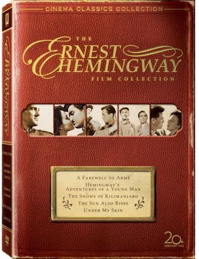
|
Hemingway Classics Collection Fox Titles Under My Skin, The Snows of Kilimanjaro,* A Farewell to Arms*, The Sun Also Rises*, Hemingway's Adventures of a Young Man Street Date March 6, 2007 / 69.98; * available separately at 19.98 |
Ernest Hemingway hasn't fared particularly well on film. Some good movies have been made from his novels and short stories: The 1932 Farewell to Arms, To Have and Have Not, For Whom The Bell Tolls, The Macomber Affair, The Breaking Point. Some of these actually capture a bit of the spirit of his writing, although even a slavish attempt to channel Hemingway like 1978's Islands in the Stream somehow seems off. Like him or hate him, Hemingway is best when read.
Fox's new Hemingway Classics Collection contains five authentic Ernest Hemingway adaptations produced by Fox between 1950 and 1962. Although a couple of them are reasonably entertaining, none are classics. The best these films do to Hemingway is to pay lip service to a few of his dialogue lines, when they don't reinterpret them into meaninglessness. Beyond that, it's a good opportunity to see some big movie stars doing their best to bring life to characters censored beyond recognition. Other fans will buy, say The Snows of Kilimanjaro just to have another handsome Bernard Herrmann soundtrack to admire.
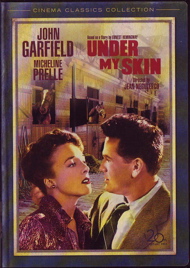
Under My Skin is a now-obscure 1950 title notable only as one of the last pictures of its star, John Garfield. The basis is Hemingway's short story My Old Man. The plot has been fleshed out with generic gangster elements and a sweet-hearted girlfriend, with anything genuinely Hemingway has been flattened out in the progress: The movie now resembles a blacklist re-think of a Wallace Beery / Jackie Cooper weepie, like The Champ.
Expelled from U.S. tracks for throwing races, jockey Dan Butler (John Garfield) is threatened and beaten by gangster Louis Bork (Luther Adler) for winning an Italian steeplechase against orders. Dan flees to Paris with his son Joe (Orley Lindgren) but finds it difficult to get work even with his jockey friend George Gardner (Noel Drayton) on his side. Dan does manage to fall in love with Paule Manet (Micheline Presle, Anglicized to Prelle) while trying to hide the crooked truth of his life from young Joe. It all eventually comes down to a big race. Dan is once again told to lose but cannot let his loved ones down.
Under My Skin is a good example of an almost pointless movie adaptation. Whatever qualities were in the original short story, the final film has reverted to a corny plot one might find in a 1914 melodrama. Conflicted Dan Butler tries to reconcile his crooked and straight lives and finds he's really a good guy underneath it all. We have a hard time believing that Butler has been rigging races for ten years. Those in the know about Garfield's sad career will see the film as an incoherent tale of the blacklist -- several of the actor's better writers and directors were forced to flee to Europe, and Garfield's death only a year or so later is said to have been blacklist-related.
The young Micheline Presle is excellent but wasted in her attempted U.S. debut; she continued her excellent career in France and is still working, 57 years later. Young Orley Lindgren had been acting for seven years and continued for a few more (Red Planet Mars). He's not bad but can't do much with the dialogue: one moment he's an innocent tot and the next, he comes out with an utterly adult observation. Luther Adler is a bland bad guy. John Garfield is always good but Casey Robinson's variable writing does him no favors. Tough guy remarks are bookended by pretentious clunkers.
Hemingway's original story was reportedly a tough-minded tale of a kid abandoned by his father; there was only a vague crime angle and no love interest. Studio economics militate against the production as well. Second-unit work on the Italian and French locations use doubles; the stars never left Hollywood. Rear projections put our actors in the picture. The whole thing ends up feeling very artificial.
Commentator Anthony Slide does a good job of keeping his track animated without admitting that there's very little reason to want to see Under My Skin. After the recent TCM docu on John Garfield, the brief featurette here seems superficial. A restoration comparison, still gallery and trailer are included.
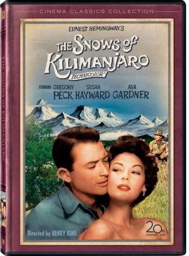
The Snows of Kilimanjaro has a positive reputation but remains watchable mostly for its star-power. Casey Robinson once again opens up a claustrophobic short story with acres of showy flashbacks. Henry King's uncluttered direction showcases three fine actresses while Gregory Peck seems miscast as a self-destructive malcontent. Peck's entire spirit radiates an easy-going harmony, fighting his character every step of the way.
Successful writer Harry Street lies on a cot in Africa, waiting for a rescue plane. An infected leg threatens his life; his wife Helen (Susan Hayward) tries to keep him comfortable while he drinks to excess and remembers his life in flashbacks. As a kid in rural Michigan Harry breaks up with his girlfriend (Helene Stanley) and runs away to Europe. There he meets the beautiful Cynthia Green. Their romance flourishes, along with Harry's writing. While on an African safari, Cynthia becomes pregnant. They break up. Harry takes up with the rich Countess Liz (Hildegard Knef aka Hildegarde Neff) but revolts against her possessive nature. While fighting in Spain, he finds Cynthia driving an ambulance. That brings Harry to Helen and back to Africa, where he's somehow decided he's a complete failure.
The Snows of Kilimanjaro has about ten minutes of really exciting footage, most of it centered on Ava Gardner. She's excellent as a playgirl prevented from settling down and raising a family, and even Henry King seems inspired whenever she's on screen. But story mechanics and Hollywood pacing prevent the film from establishing any of its various places and atmospheres -- Parisian garret, Riviera villa. New telegrams and letters keep arriving to keep Harry Street on the move.
Even the framing story in Africa has a rushed theatricality. Hayward and Peck clearly never left the elaborate veldt set on a Fox sound stage. Leon Shamroy's cinematography is almost perfectly matched (compare the African skies), yet Harry and Helen's arguments over his septic leg are little better than a one-act play. Peck unfortunately never convinces when he tries to play a jerk like Harry; although he can be superb as a lost or confused man, as in The Purple Plain or On the Beach.
Hemingway writes tough characters, and film adaptations tend to be merciless on characters he doesn't like. Hildegard Knef is another European actress whose American dreams were sunk playing a Hemingway woman. Knef's "Ice Countess" is a b____ plain and simple. She apologizes for not 'being enough' for Harry, and sculpts nude women into laughably Freudian shapes, with empty spaces where a womb and breasts belong. Poor Ms. Knef was stereotyped as 'cold and Teutonic" and never got a proper chance at Hollywood.
The Snows of Kilimanjaro looks much better than usual in this colorful transfer, which shows that serious second unit work was done in Africa -- no sloppy 16mm blowups as were used in John Ford's Mogambo. Bernard Herrmann's beautiful score is well represented, even the Parisian cue that's 'borrowed' from his own Citizen Kane.
The commentary this time is by Patricia King Hanson and Frank Thompson. Their leisurely work covers the required bases, mostly comparing the film to the short story and other Hemingway adaptations. They point out that Ava Gardner's role is almost the same as in the later The Sun Also Rises.
We're honestly surprised when the movie hits scenes in the Spanish Civil War. Paris with its jazz spots could have been 1950 and nothing in the film's look clued us that everything was happening in the early 30's. The impression given by all of these Hemingway films is that whenever a characterization runs into trouble, the solution is to make them suddenly become a battlefront ambulance driver!
A new featurette covers the making of the film while added audio recordings' are included with director Henry King and writer Casey Robinson. A trailer and a still gallery round out the disc.
| The 1957 A Farewell to Arms is a reissue with new cover art; Savant reviews the previous release here. |
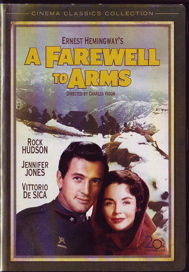
|

The biggest show is the set is Darryl F. Zanuck's 1957 The Sun Also Rises, an impressive epic filmed on real European locations. When Zanuck went into independent production, he didn't restrict himself to Hollywood rear projections, as was the earlier norm. This show travels to Paris and Spain, and cleverly lets Mexico City stand in for parts of Spain, especially a large bullring.
Half of the movie's casting decisions are good and the other half mediocre, and the tough edge of Hemingway's original book is dulled. Tyrone Power is suitably troubled-looking but too old, setting off vibes of his youthful beauty in Blood and Sand. His Jake Barnes is at least allowed to be openly labeled as "impotent", but without further explanation we're supposed to conclude that impotence is the final End of Manhood forever -- if Jake is that dedicated to his missing anatomical functions we wonder why he doesn't just kill himself. Like the rest of his Lost Generation peers, Jake really needs that problem as an excuse for deciding that life is just too existentially meaningless to commit to the work of living. Sometimes I think that Hemingway wanted to invent a lifestyle to flatter his own aimlessness -- of all the victims of WW1, these affluent, talented and beautiful survivors are not high on my list of people to be pitied.
There would be no movie without Ava Gardner, as she provides the sexual attraction to keep everyone's blood flowing, if only with curiosity. Her Lady Brett Ashley is about as English as a Dixie beauty queen. The Production Code prohibits her from being the fully promiscuous sleep-with-whoever tramp specified by Hemingway. Here she's just a confused girl who follows her heart in destructive directions, mainly because she can't have Jake, the man she loves. I have a feeling that if the pair really cared for each other, a short discussion of biological workarounds would suffice to give them some kind of intimate satisfaction. Does Jake not like Brett's company, or is he too wrapped up in his wounded self-identity? I accept the character, but just don't tell me he's really in love.
Fluttering around the periphery is Eddie Albert, just okay in yet another role as the sexless buddy to the hero. Errol Flynn adds the movie's second star-power center of interest by basically playing an Errol Flynn-like bankrupt nobleman who avoids misery by staying perpetually potted. Drunk humor is unfortunately not as sure-fire as it used to be, although we're amused when Flynn's Mike Campbell decides to face a Pamplona bull using one of his bounced checks for a shield. I want to suffer Campbell's kind of bankruptcy -- supposedly penniless, he nevertheless picks up restaurant checks and lives in luxury hotels.
Mel Ferrer is an almost complete loss as Robert Cohn, the boxer. Whatever special treatment the actor needed, he didn't get, because he sounds false almost all the time. I'm informed that Hemingway Cohen comes off as much more of a louse in the book.
The kiss of death is Robert Evans, who as the supposedly magnetic matador Pedro Romero projects no charm whatsoever. In most of his close-ups, Evans looks cross-eyed or mentally challenged, and his line deliveries make Ferrer look like Brando. When Gardner's Brett tosses everything to the wind to follow Evans' Pedro, the movie goes out the side door and doesn't come back.
Fortunately, The Sun Also Rises is easy to look at, thanks to splendid location photography by Leo Tover. The principal players are well integrated with the Pamplona fiesta activities and we get a fine sense of Spain even though much of the action was filmed in Mexico. We're happy to watch as the cast enjoys the bullfights. As with The Snows of Kilimanjaro, The Sun Also Rises has a poor sense of period. Costumes, hairstyles and music never seem like the 1920s, so that when an old flivver auto shows up, we wonder if the people have gone to Disneyland. The Spanish sequences fare better because they seem to exist away from temporal references -- just lots of people celebrating in the streets.
Patricia King Hanson and Frank Thompson are back looking for things to talk about to cover the 130 minutes of The Sun Also Rises. Neither can make sense of the pompous opening and closing narration over a Paris bridge at sunset, even though it comes straight from the book. They do well when introducing actors in smaller roles, especially the under-appreciated Juliette Greco, who was surely Darryl Zanuck's most talented ... protégeé during his wild-man European producing years. (When is Fox going to bring out the eco-epic The Roots of Heaven?)
A new featurette covers the making-of angle. Another audio recording with Henry King is included. In another featurette entitled Hemingway on Film author Kelly Dupuis and professor Charles Oliver examine the author's take on Gertrude Stein's Lost Generation. They're both exceedingly generous when defending the movies, placing most of the blame on the production code.
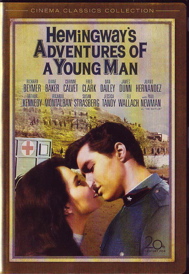
Hemingway's Adventures of a Young Man is unfairly considered a disaster, although it's not particularly successful, either. An episodic amalgam of a number of Nick Adams stories, it retraces steps already covered in the other films. Young Adams (Richard Beymer, far better than he's given credit for) rejects his girl in Michigan and goes on the road, eventually ending up as -- what else -- an ambulance driver for the Italians in WW1. There he finds the hardships, macho challenges and cruel heartbreak that will transform him (ta-dah!) into a great writer. It's pat but also entertaining, and the show only becomes a chore when we realize that the interesting actors we meet are just stepping-stones in the young man's progress toward .... ah ... wisdom? Self knowledge? Since most of Hemingway's heroes run smack into a wall when trying to make sense of their experiences, Adventures has no choice but to end as a big question mark.
Young Adams rebels against the supposed cowardice of his father (Arthur Kennedy), who will not stand up to his domineering wife Rosanna (Jessica Tandy). The lack of shading in this relationship is almost absurd. Because pop puts up with mom's tyranny, he must be a miserable failure, and must kill himself. That equation must have fared better in the short stories. Adams dumps his teenage fiancée, played by Diane Baker. She's on screen for about 30 seconds and has little to do but furrow her brow, hand back his ring and disappear ... it's a complete waste of Baker's time.
Adams then goes 'cross country, collecting 'character building' experiences courtesy of more Nick Adams stories folded into the stew by writer A. E. Hotchner. Paul Newman is an addled ex-boxer cared for by Juano Hernandez. Dan Dailey is a drunken publicity man for Fred Clark's burlesque showman. James Dunn ( A Tree Grows in Brooklyn) has a walk-on as a kindly telegrapher who helps Adams decide not to go home.
Nick Adams goes to Europe and meets a macho role model, Ricardo Montalban's Italian officer. Eli Wallach is delightful as an Italian-American medic drafted into the service; Wallach was himself an army medic in WW2. Susan Strasberg has the thankless role of the sweet Italian nurse that cares for Adams and becomes engaged to him, in a dinner-theater repeat of main plot points from A Farewell to Arms.
Young Michael J. Pollard is a pal back home, Simon Oakland a goonish trapper, and Mel Welles an unlucky Italian sergeant. In a brief taste of Jack London or Emperor of the North, Ed Binns is properly brutal as a railroad brakeman with a tough lesson for Nick. We're also told that Sharon Tate is in there somewhere, although I didn't spot her.
Hemingway's Adventures of a Young Man has Lee Garmes' beautiful 'Scope photography of the Michigan woods and Italian mountains. Once it gets past the dead-end Paul Newman and Dan Dailey scenes, the picture always keeps our attention. Richard Beymer is decent as Nick Adams but his character's personal growth (getting wounded, losing his girlfriend to an Austrian bombardment) plays a bit like "Ernest Hemingway's Greatest Hits."
This time Patricia King Hanson and Frank Thompson's commentary strains to flatter the film while minimizing their own disappointment at its problems, like the abuse of actress Diane Baker. There are even more silent passages in the commentary, which makes it frustrating to sit through the film a second time to listen to it.
The featurettes pick up in interest thanks to the participation of screenwriter A.E. Hotchner, whose poat-war connection to Hemingway is a fascinating story. A New York publisher sent Hotchner to solicit writing from the author and became sort of an official television adaptor of Hemingway's short stories. Hotchner also contributes his thoughts to Hemingway's suicide and then continues with a piece about Paul Newman. Hotchner credits Newman's career to his appearance in a Nick Adams TV play, reinforcing the unflattering notion that Newman had a career only because roles intended for James Dean fell into his lap.
All of the transfers in the Hemingway Classics Collection are terrific. The Snows of Kilimanjaro hasn't looked this good in a long time, and the later CinemaScope pictures are almost flawless.
The numerous featurettes on the discs are produced by John Cork. They're handsomely taped and edited but show the limitations of the DVD extras format. After viewing them all we get the feeling we've seen the same stills and heard variations on the same opinions five times over. And that's not including the commentaries that cover the same content.
The Hemingway Classics Collection contains a couple of the biggest adaptations from the author's work, but nothing as good as the beautiful For Whom the Bell Tolls, or as intimate-tough as The Breaking Point. All function well as entertainment, but only a couple get anywhere near the Classics category.
On a scale of Excellent, Good, Fair, and Poor,
|
Under My Skin rates:
Movie: Fair + Video: Excellent Sound: Excellent Supplements: Commentary with Anthony Slide, Featurette Racing with Fate: John Garfield, Restoration Comparison, trailer, still gallery. |
The Snows of Kilimanjaro rates:
Movie: Very Good Video: Excellent Sound: Excellent Supplements: Commentary by Patricia King Hanson and Frank Thompson, Featurette The Snows of ZanuckL The Making of Kilimanjaro, audio conversations with Henry King and Casey Robinson, Restoration Comparison, trailer, still gallery. |
|
A Farewell to Arms rates:
Movie: Fair ++ or Good -- Video: Excellent Sound: Excellent Supplements: Trailer, 3 Fox Movietone News short subjects |
The Sun Also Rises rates:
Movie: Very Good Video: Excellent Sound: Excellent Supplements: Commentary by Patricia King Hanson and Frank Thompson, Featurette The Old Men and the Bulls, Featurette Hemingway on Film, Restoration Comparison, trailer, still gallery. |
|
Hemingway's Adventures of a Young Man rates:
Movie: Good Video: Excellent Sound: Excellent Supplements: Commentary by Patricia King Hanson and Frank Thompson, Featurette Remembering Ernest: A.E. Hotchner's Adventures with Hemingway, Featurette Papa's Last Days, Featurette A.E. Hotchner & Paul Newman: A Legacy of Charity, Restoration Comparison, trailer, still gallery. |
Packaging: Five slim cases in card sleeve Reviewed: March 22, 2007 |
Review Staff | About DVD Talk | Newsletter Subscribe | Join DVD Talk Forum
Copyright © MH Sub I, LLC dba Internet Brands. | Privacy Policy | Terms of Use
|
| Release List | Reviews | Price Search | Shop | SUBSCRIBE | Forum | DVD Giveaways | Blu-Ray/ HD DVD | Advertise |





